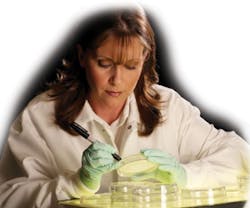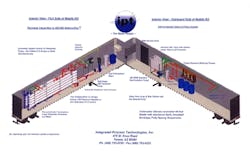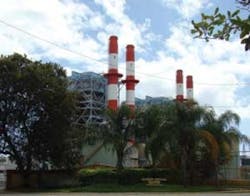Managing Micro-pollutants
Emerging contaminants such as pharmaceuticals in drinking water may not be a new issue but advancements in analytical technologies are enabling companies to detect them with greater sensitivity. Rhonda Day looks at how technologies, such as performance liquid chromatographs, are helping in the battle against micro-pollutants.
Due to the recent media attention concerning the detection of pharmaceuticals and personal care products (PPCPs) in waters worldwide, one might speculate that this is a new development. However, PPCPs were first reported in US waters by the United States Environmental Protection Agency (USEPA) in 1975.
The consumption of PPCPs has increased significantly over the last 35 years, triggering a rise in the potential of PPCPs entering water supplies. The fact that more PPCPs are found today than in the past is not entirely due to greater contamination of the water. In large part it is due to the advancement in analytical technologies, which now enable us to detect these compounds at very low concentrations in which they are occurring.
PPCPs refer, in general, to any product used by individuals for personal health or cosmetic reasons as well as those used by the agricultural industry to enhance growth or health of livestock. PPCPs comprise a diverse collection of thousands of chemical substances, including prescription, veterinary, and over-the-counter therapeutic drugs, fragrances, cosmetics, sun-screen agents, diagnostic agents, nutraceuticals, biopharmaceuticals, growth enhancing chemicals used in livestock operations, and many others [1].
In reference to their occurrence in the environment, they are included in a class of compounds generally referred to as "contaminants of emerging concern" (CECs) [2].
CECs pose concern because the risk to human health and the environment associated with their presence, frequency of occurrence, or origin of contamination are not well understood. The USEPA is working to improve its understanding of a number of CECs, particularly PPCPs and perfluorinated compounds, among others [3]. Like other emerging contaminants, PPCPs are thought to enter the environment through excretion, bathing, the disposal of medications in sewers, septic tanks, or trash, and landfill runoff. Many of these compounds dissolve easily in water and do not evaporate at normal temperature and pressure. This class of compounds causes concern in drinking water and aquatic environments, because they are designed to interact with cellular receptors at low concentrations to induce specific biological effects.
Scientific Research
Contaminants of emerging concern such as PPCPs have received worldwide attention in the last couple of years. The presence of PPCPs in source and finished drinking water has generated concern among governments/regulators, member states, industry, municipalities, and the public. More concerning is that an increase in the use of pharmaceuticals is anticipated as the world's population gets older. Also, there is an expected increase in the use of veterinary and agricultural drugs worldwide.
There are a number of critical issues regarding the occurrence, human health effects, and treatment and disposal options for PPCPs in the environment, drinking water, and wastewater treatment systems. For compounds such as pharmaceuticals, we are only now beginning to understand how widespread these contaminants are—and at what levels they occur.
WHO has a task force that consists of scientists from Singapore, Japan, United Kingdom, Canada, Tanzania, Australia, Germany, Malaysia, Netherlands, and the United States [4]. This task force intends to address:
- Environmental occurrence and sources of PPCPs in finished drinking water and source water
- Approaches to assess health risks to vulnerable populations
- Environmental chemistry of PPCPs in natural waters
- Advances in treatment methods and analytical methods, including treatment effectiveness
- Availability of data and information to assess risks to human health
- Existing pharmaceutical take-back and safe disposal programs to reduce water pollution.
In light of emerging technologies in drinking water, numerous analytical technologies have been developed and used, including high performance liquid chromatograph with triple quadruple mass spectrometer (HPLC/MS/MS). This technology, coupled with various sample preparation techniques, has enabled several analytical methods to be developed that can detect a wide range of emerging contaminants in the parts per trillion concentration range.
Table 1 lists the ten most frequently detected PPCPs in drinking water samples analysed by Underwriters Laboratories (UL). It is especially notable that these are found in the parts per trillion (ppt) range, which is the equivalent to about three seconds out of one hundred thousand years.
In past years, these compounds would most likely not have been detected due to the fact that the technological capabilities at the time were only in the parts per billion (ppb) range, which is equivalent to about three seconds out of a century. While the concentrations of PPCPs found in water supplies are millions of times lower than a medical dose, research is underway to determine if these contaminants pose any health risks to humans and ecological systems at these concentrations.
In addition to drinking water, PPCPs have been detected in wastewater treatment plant effluent, surface water and groundwater. However, conventional water treatment systems are not specifically engineered or equipped to remove these compounds. Research has demonstrated however that some treatment technologies are effective in removing PPCPs depending on the chemical class of the contaminants. The following is a list of several PPCP classifications along with the degree of removal using some different treatment technologies [5]:
- Steroids are removed ≥ 90% using activated sludge, activated carbon, biologically activated carbon, ozone/advanced oxidation processes, UV and reverse osmosis.
- Antibiotics, antidepressants, and antimicrobials are removed ≥ 90% using activated carbon, biologically activated carbon, nanofiltration and reverse osmosis.
- Anti-inflammatories are removed ≥ 90% using activated carbon, biologically activated carbon, ozone/advanced oxidation processes, UV, nanofiltration, and reverse osmosis.
- Lipid regulators are removed ≥ 90% using activated carbon, biologically activated carbon, ozone/advanced oxidation processes, nanofiltration, and reverse osmosis.
- Coagulation/flocculation and softening/metal oxides are less effective in removing the listed PPCPs (≤ 40%).
Public Concerns
Some of the PPCPs of concern, such as galaxolide (fragrance), estrone, progesterone and testosterone (steroid hormones), have been identified as endocrine disrupting compounds (EDCs). The endocrine system is a complex network of hormones and glands which releases hormones into the body and regulates growth, development and maturation. EDCs are synthetic chemicals which either block or mimic natural hormones, which in turn disrupt normal functioning of organs.
EDCs can have effects on the human endocrine system at extremely low concentrations. Although research has not confirmed that exposure to EDCs from drinking water sources leads to adverse health effects in humans, EDCs have been implicated as having adverse effects on aquatic organisms that are exposed to wastewater in the environment. Another concern is the misuse/overuse of antibiotics, which can lead to the evolution of drug-resistant pathogens in the environment.
Although experts are working to develop new antibiotics and other treatments to keep pace with antibiotic-resistant strains of bacteria, infectious organisms can adapt quickly. Antibiotic-resistant bacteria will continue to be a global health concern — and using antibiotics wisely is important for preventing their spread. According to the federal Centers for Disease Control and Prevention, 70% of 1.7 million infections acquired in hospitals every year are resistant to at least one drug. WHO warns that increasing pathogen drug resistance could significantly reduce our ability to cure illnesses and stop epidemics [6].
Pollution Prevention
Another concern are the long-term effects of the nearly continuous presence of multiple chemicals at the same time in drinking water and bioaccumulation of these mixtures. USEPA has research underway to help understand whether very low levels of pharmaceuticals in water might present a risk to human health. It is commissioning the National Academy of Sciences to provide expert scientific advice on how to determine potential risks to human health.
A primary goal of the USEPA's Office of Research and Development is to identify and foster investigation of potential environmental issues/concerns before they become critical ecological or human health problems. Pollution prevention (e.g. source elimination or minimisation) is preferable to remediation or restoration to minimise both public cost and human/ecological exposure [7].
USEPA has drinking water regulations for more than 90 contaminants - for example the Safe Drinking Water Act (SDWA) has established processes for identifying and regulating drinking water contaminants to protect human health. The Candidate Contaminant List (CCL) and the Unregulated Contaminant Monitoring Rule (UCMR) are processes that entail great scientific rigor. USEPA must periodically publish a list of contaminants (CCL) and decide whether to regulate at least five or more contaminants on the list. USEPA uses this list of unregulated contaminants to prioritise research and data collection efforts to help determine whether to regulate a specific contaminant.
PPCPs
The following is a list of organisations that are researching different aspects of PPCPs:
- United States Environmental Protection Agency (USEPA)
- United States Geological Society (USGS)
- Water Research Foundation (formerly American Water Works Association Research Foundation, (WERF)
- World Health Organization (WHO)
The Unregulated Contaminant Monitoring program is used to collect data for contaminants suspected to be present in drinking water, but that do not have health-based standards set under the SDWA. This data assists in determining whether or not to regulate those contaminants. Sound science and reliable information must be the foundation for any agency decision. USEPA has several activities underway to strengthen the science for understanding the behavior of PPCPs in water including research, methods development and occurrence studies.
Conclusion
There are a number of critical issues regarding the occurrence, human health effects, impact on ecological systems, and treatment and disposal options for PPCPs in the environment, drinking water and wastewater treatment systems. While the presence of emerging contaminants such as pharmaceuticals is not a new issue in water, recent advancements in analytical technologies enable laboratories to analyse for more contaminants in drinking water and do so with greater specificity and sensitivity than ever before.
The fact that contaminants are detected in trace amounts does not alone imply risk to humans. Significant research is still needed in order to understand both the scope of the problem and its implications for our public drinking water supply. Considering the continued advancements in analytical technologies, today's non-detectable contaminants will be tomorrow's contaminants of emerging concern. WWi
REFERENCES
2 Fono & McDonald, 2008. Emerging Compounds: A concern for water and wastewater utilities. J. AWWA, 100:11:50-57.
4 http://www.epa.gov/waterscience/ppcp/studies/who.html
5 Snyder, S.A.; Westerhoff, P.; Yeomin, Y.; Sedlak, D.L., 2003. Pharmaceuticals, Personal Care Products, and Endocrine Disruptors in Water: Implications for the Water Industry. Envir. Engrg. Sci., 20:5:449.
Author's note:Rhonda Day is the custom analytical services manager for UL's drinking water analytical services, which focuses on analysis of contaminants not currently regulated in drinking water. Rhonda has been with UL for 20 years and holds a Bachelor of Science degree in chemistry from Beloit College.
More Water & WasteWater International Current Issue Articles
More Water & WasteWater International Archives Issue Articles




